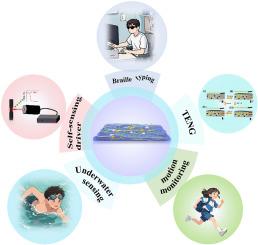Novel multifunctional composite ionogels for smart actuation, underwater sensing, and self-powered Braille communication systems
IF 14.2
1区 材料科学
Q1 ENGINEERING, MULTIDISCIPLINARY
引用次数: 0
Abstract
The multifunctional integration properties of biological tissues provide significant bionic insights for designing intelligent materials, driving the advancement of materials science toward multifunctional coupling. Traditional flexible materials often face challenges in achieving property compatibility and functional synergy, especially under complex environments. To address these challenges, this work developed a novel composite ionogel based on poly (vinylidene fluoride-co-hexafluoropropylene) (PVDF-HFP) and PEDOT:PSS, which exhibits toughness, frost resistance, underwater stability, and shape memory functionality. The incorporation of conductive filler PEDOT:PSS synergistically optimizes the mechanical properties, near-infrared-responsive functionality and conductivity of composite ionogels. The ionogels exhibit superior thermo/light dual-response shape memory behavior, with shape fixation and recovery rates both exceeding 98 %. Based on the light-responsive shape memory performance, the ionogels can lift objects 22 times its own weight and enable real-time monitoring of the actuation process through the resistance variation induced by shape recovery. The ionogel's underwater environmental stability and enhanced conductivity allow its strain sensors to effectively monitor human joint movements, such as finger and wrist bending, in both terrestrial and aquatic environments. Additionally, a self-powered pressure sensor fabricated with this ionogel serving as both the friction and conductive layers exhibits a high sensitivity of 5.890 V kPa−1, enabling real-time human activity capture and facilitating an innovative braille typing assistance system for the visually impaired. This work offers novel insights into the engineering of material properties and the integration of multifunctionalities, thereby promoting the advancement of multifunctional material systems.

新型多功能复合离子凝胶,用于智能驱动,水下传感和自供电盲文通信系统
生物组织的多功能集成特性为智能材料的设计提供了重要的仿生学见解,推动了材料科学向多功能耦合的方向发展。传统柔性材料在实现性能相容性和功能协同方面经常面临挑战,特别是在复杂环境下。为了应对这些挑战,本研究开发了一种基于聚偏氟乙烯-共六氟丙烯(PVDF-HFP)和PEDOT:PSS的新型复合离子凝胶,具有韧性、抗冻性、水下稳定性和形状记忆功能。导电填料PEDOT:PSS的加入协同优化了复合电离胶的机械性能、近红外响应功能和电导率。离子凝胶具有优异的热/光双响应形状记忆性能,其形状固定率和恢复率均超过98%。基于光响应形状记忆性能,离子凝胶可以举起22倍于自身重量的物体,并可以通过形状恢复引起的阻力变化实时监测驱动过程。电离凝胶的水下环境稳定性和增强的导电性使其应变传感器能够有效地监测人类关节运动,如手指和手腕弯曲,在陆地和水生环境中。此外,用这种离子凝胶作为摩擦层和导电层制成的自供电压力传感器具有5.890 V kPa−1的高灵敏度,可以实时捕捉人体活动,并为视障人士提供创新的盲文打字辅助系统。这项工作为材料特性的工程和多功能的集成提供了新的见解,从而促进了多功能材料系统的发展。
本文章由计算机程序翻译,如有差异,请以英文原文为准。
求助全文
约1分钟内获得全文
求助全文
来源期刊

Composites Part B: Engineering
工程技术-材料科学:复合
CiteScore
24.40
自引率
11.50%
发文量
784
审稿时长
21 days
期刊介绍:
Composites Part B: Engineering is a journal that publishes impactful research of high quality on composite materials. This research is supported by fundamental mechanics and materials science and engineering approaches. The targeted research can cover a wide range of length scales, ranging from nano to micro and meso, and even to the full product and structure level. The journal specifically focuses on engineering applications that involve high performance composites. These applications can range from low volume and high cost to high volume and low cost composite development.
The main goal of the journal is to provide a platform for the prompt publication of original and high quality research. The emphasis is on design, development, modeling, validation, and manufacturing of engineering details and concepts. The journal welcomes both basic research papers and proposals for review articles. Authors are encouraged to address challenges across various application areas. These areas include, but are not limited to, aerospace, automotive, and other surface transportation. The journal also covers energy-related applications, with a focus on renewable energy. Other application areas include infrastructure, off-shore and maritime projects, health care technology, and recreational products.
 求助内容:
求助内容: 应助结果提醒方式:
应助结果提醒方式:


